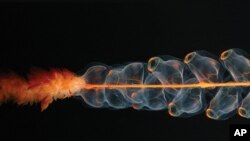An ambitious 10-year project to explore the world's oceans finds that marine life is richer, more connected and changing faster than expected.
The first Census of Marine Life - one of the largest scientific collaborations ever - discovered 6,000 new underwater species.
Exploring the ocean depths
Since the census began 10 years ago, 2,700 scientists from 80 countries logged 540 expeditions to document the diversity, distribution and abundance of marine life.
Oceanographer Paul Snelgrove, a professor at Memorial University of Newfoundland sums up the 10-year effort in his new book "Discoveries of the Census of Marine Life: Making Ocean Life Count," released with the census.
"With a fair degree of confidence we now know about 250,000 described species for the ocean," says Snelgrove. "And that this is about 25 percent of what actually lives there. So there are still three to four species yet to be discovered for every one that we know about."
Scientists have deployed robots to explore the ocean depths and established an underwater network of microphones to track salmon and other migrants from Alaska to Mexico. More than 4,000 marine creatures of 23 species have been tagged with electronic sensors.
Lasting legacy
Researchers are also building a database of DNA records. Snelgrove says a publicly accessible digital archive is one of the single greatest legacies of the census.
"This dataset is available to managers, to conservation groups or even to individuals who want to know what sorts of animals live near them in the ocean."
Among the newly discovered species are a hairy crab, a carnivorous sponge and an ancient shrimp thought to have gone extinct 50 million years ago. The census also determined that - by weight - up to 90 percent of all marine life is tiny microbes. Over the decade, census scientists published 2,600 academic papers.
Snelgrove says he is already seeing the research put to practical use. "There are areas in the Arctic and in the Antarctic and also along the mid-Atlantic Ridge which have received elevated protection as a result of information of data that the census has provided. And I think in the future there will be many more protected areas in the ocean and with this data we have much more useful knowledge on where to best locate them."
Starting point
The knowledge the census has provided about sea life is just a beginning, Snelgrove says.
Much of the ocean remains unexplored, leaving many unanswered questions in its depths. "We see this tremendous array of species, but broadly speaking most of the species in the ocean we don't know what they do for us and what they do for the ecosystem. And so that raises the question of course, if you lose those species, does that change the ecosystem does it compromise the health of the oceans and so that's something that needs to be a priority in the coming years."
Snelgrove hopes the Census of Marine Life ignites a sense of urgency to protect the ocean, which he says is key to our own survival. "I think that we need to accept the fact that we need the fish that we extract from the oceans and the other sorts of fisheries that we have, but we do need to find a way to make them sustainable and to find a way to preserve the biodiversity in the oceans as well as those fisheries because the two of those are very strongly interlinked."
The 10-year $650-million Census of Marine Life received initial support from the Alfred P. Sloan Foundation and later from governments, institutions and laboratories around the world.











